
The giraffe is a large African hoofed mammal belonging to the genus Giraffa. It is the tallest living terrestrial animal and the largest ruminant on Earth. Traditionally, giraffes have been thought of as one species, Giraffa camelopardalis, with nine subspecies. Most recently, researchers proposed dividing them into four extant species due to new research into their mitochondrial and nuclear DNA, and individual species can be distinguished by their fur coat patterns. Seven other extinct species of Giraffa are known from the fossil record.

Artiodactyls are placental mammals belonging to the order Artiodactyla. Typically, they are ungulates which bear weight equally on two of their five toes. The other three toes are either present, absent, vestigial, or pointing posteriorly. By contrast, most perissodactyls bear weight on an odd number of the five toes. Another difference between the two orders is that many artiodactyls digest plant cellulose in one or more stomach chambers rather than in their intestine. Molecular biology, along with new fossil discoveries, has found that cetaceans fall within this taxonomic branch, being most closely related to hippopotamuses. Some modern taxonomists thus apply the name Cetartiodactyla to this group, while others opt to include cetaceans within the existing name of Artiodactyla. Some researchers use "even-toed ungulates" to exclude cetaceans and only include terrestrial artiodactyls, making the term paraphyletic in nature.

The Giraffidae are a family of ruminant artiodactyl mammals that share a recent common ancestor with deer and bovids. This family, once a diverse group spread throughout Eurasia and Africa, presently comprises only two extant genera, the giraffe and the okapi. Both are confined to sub-Saharan Africa: the giraffe to the open savannas, and the okapi to the dense rainforest of the Congo. The two genera look very different on first sight, but share a number of common features, including a long, dark-coloured tongue, lobed canine teeth, and horns covered in skin, called ossicones.
Paleoanthropology or paleo-anthropology is a branch of paleontology and anthropology which seeks to understand the early development of anatomically modern humans, a process known as hominization, through the reconstruction of evolutionary kinship lines within the family Hominidae, working from biological evidence and cultural evidence.
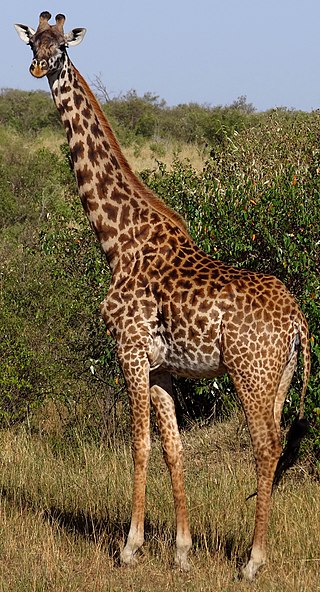
The Masai giraffe, also spelled Maasai giraffe, and sometimes called the Kilimanjaro giraffe, is a species or subspecies of giraffe. It is native to East Africa. The Masai giraffe can be found in central and southern Kenya and in Tanzania. It has distinctive jagged, irregular leaf-like blotches that extend from the hooves to its head. The Masai giraffe is currently the national animal of Tanzania.

The northern giraffe, also known as three-horned giraffe, is the type species of giraffe, G. camelopardalis, and is native to North Africa, although alternative taxonomic hypotheses have proposed the northern giraffe as a separate species.

Paranthropus boisei is a species of australopithecine from the Early Pleistocene of East Africa about 2.5 to 1.15 million years ago. The holotype specimen, OH 5, was discovered by palaeoanthropologist Mary Leakey in 1959 at Olduvai Gorge, Tanzania and described by her husband Louis a month later. It was originally placed into its own genus as "Zinjanthropus boisei", but is now relegated to Paranthropus along with other robust australopithecines. However, it is also argued that Paranthropus is an invalid grouping and synonymous with Australopithecus, so the species is also often classified as Australopithecus boisei.

Hippopotamus gorgops is an extinct species of the genus Hippopotamus known from remains found in Northern Africa, Eastern Africa, and the Levant. One of the largest hippopotamus species, it first appeared during the late Pliocene-Early Pleistocene, and became extinct during the early Middle Pleistocene.
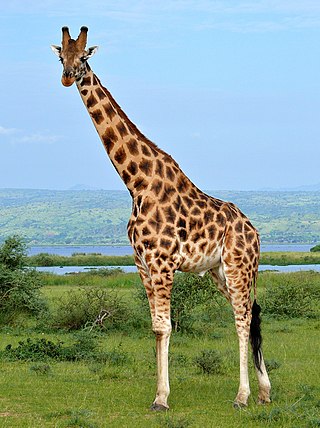
Rothschild's giraffe is an ecotype of the Nubian giraffe. It is one of the most endangered distinct populations of giraffe, with 1,399 mature individuals estimated in the wild in 2018.

Honanotherium is a genus of extinct giraffid from the late Miocene of Henan Province, China, and East Azerbaijan Province, northwestern Iran. It was closely related to Bohlinia and was once thought to be ancestral to the modern giraffe. The living animal would have resembled a modern giraffe, but was somewhat shorter, with more massive ossicones.
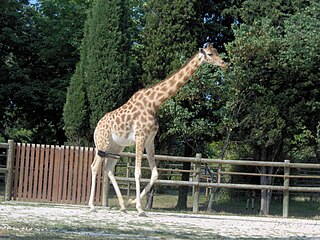
The Kordofan giraffe is a species or subspecies of giraffe found in northern Cameroon, southern Chad, the Central African Republic, and possibly western Sudan. They usually live in tree savannas, bush savannas and thorn savannas. Compared to most other subspecies, the Kordofan giraffe is relatively small at 3.8 to 4.7 meters, with more irregular spots on the inner legs. There are around 2,300 individuals living in the wild. In the wild, female Kordofan giraffes live in loose groups, whilst males live solitary. They have an average lifespan of around 35 years.
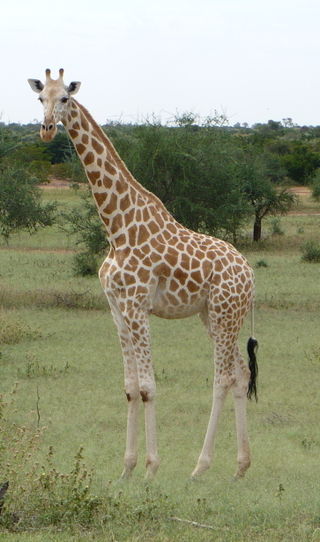
The West African giraffe, also known as the Niger giraffe, is a species or subspecies of the giraffe distinguished by its light colored spots. Its last self-sustaining herd is in southwest Niger, supported by a series of refuges in Dosso Region and the tourist center at Kouré, some 80km southeast of Niamey.

The South African giraffe or Cape giraffe is a species or subspecies of giraffe found in South Africa, Namibia, Botswana, Zimbabwe, Eswatini and Mozambique. It has rounded or blotched spots, some with star-like extensions on a light tan background, running down to the hooves.
Maboko Island is a small island lying in the Winam Gulf of Lake Victoria, in Nyanza Province of western Kenya. It is about 1.8 km long by 1 km wide. It is an important Middle Miocene paleontological site with fossiliferous deposits that were discovered in the 1930s. The age of the deposits is estimated to be 15 to 16 million years, and they are especially important for the abundance of primate fossils they contain.

Thornicroft's giraffe, also known as the Rhodesian giraffe or Luangwa giraffe, is a subspecies of giraffe. It is sometimes considered a species in its own right or a subspecies of the Masai giraffe. It is geographically isolated, occurring only in Zambia’s South Luangwa Valley. An estimated 550 live in the wild, with no captive populations. Its lifespan is 22 years for males and 28 years for females. The ecotype was originally named after Harry Scott Thornicroft, a commissioner in what was then North-Eastern Rhodesia and later Northern Rhodesia.
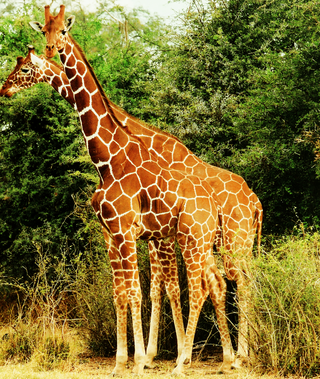
The reticulated giraffe is a species/subspecies of giraffe native to the Horn of Africa. It is differentiated from other types of giraffe by its coat, which consists of large, polygonal, block-like spots, which extend onto the lower legs, tail and face. These prominent liver-red spots also show much less white between them, when compared to other giraffe species. With up to 6 meters in height, the reticulated giraffe is the largest subspecies of giraffe and the tallest land animal in general. While the reticulated giraffe may yet still be found in parts of its historic range, such as areas of Somalia and Ethiopia, its population stronghold is primarily within Kenya. There are approximately 8,500 individuals living in the wild. In both captivity and the wild, as of 2024 there are 15,785 individuals across the world.
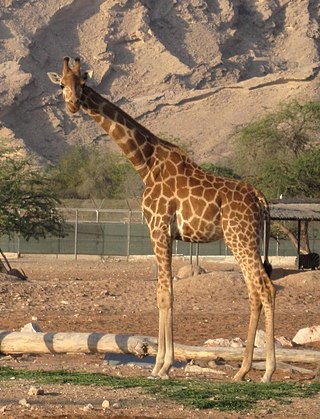
The Nubian giraffe, also known as Baringo giraffe or Ugandan giraffe, is the nominate subspecies or species of giraffe. It is found in Ethiopia, Kenya, Uganda, South Sudan and Sudan. It is currently extinct in the wild of the Democratic Republic of Congo, Egypt and Eritrea. The Nubian giraffe used to be widespread in northeast Africa. The subspecies was listed as Critically Endangered by the IUCN in 2018 for the first time due to a 95% decline in the past three decades.

The Angolan giraffe, also known as the Namibian giraffe or smokey giraffe, is a species or subspecies of giraffe that is found in northern Namibia, south-western Zambia, Botswana, western Zimbabwe and since mid-2023 again in Angola.

The southern giraffe, also known as two-horned giraffe, is a species of giraffe native to Southern Africa. However, the IUCN currently recognizes only one species of giraffe with nine subspecies.

Cercopithecoides is an extinct genus of colobine monkey from Africa which lived during the latest Miocene to the Pleistocene period. There are several recognized species, with the smallest close in size to some of the larger extant colobines, and males of the largest species weighed over 50 kilograms (110 lb).




















